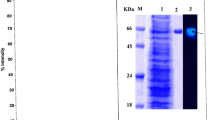Abstract
Extracellular partially purified endo (1→4) β-d-glucanase belong to CAZy Family GH12 produced by Bacillus licheniformis KIBGE-IB2 was immobilized within the microenvironment of calcium alginate beads using entrapment technique. Immobilization technology is one of the supporting technique for obtaining purified product with cost effectiveness. The activities of soluble and immobilized endo (1→4) β-d-glucanase were compared using carboxymethyl cellulose (CMC) as a substrate. The results showed that the maximum immobilization of enzyme was achieved when calcium chloride (0.2 M) and sodium alginate (2.0%) were used. The pH optima of soluble and immobilized enzyme remain same, but temperature optima (60 °C) of entrapped enzyme shifted to a higher level (70 °C) as compared to soluble enzyme. The scanning electron microscopy analysis reveals the changes in morphology and size of micro pores on the surface of calcium alginate before and after immobilization. The immobilized enzyme showed its reusability up to five cycles. The stability against various inhibitors was also improved after immobilization.
Graphical Abstract







Similar content being viewed by others
References
Lynd LR, Weimer PJ, Van Zyl WH, Pretorius IS (2002) Microbial cellulose utilization: fundamentals and biotechnology. Microbiol Mol Bio Rev 66:506–577
Bhat MK (2000) Cellulases and related enzymes in biotechnology. Biotech Advant 18:355–383
Sukumaran RK, Singhania RR, Pandey A (2005) Microbial cellulases-production, applications and challenges. J Sci Ind Res 64:832–844
Ahmed S, Bashir A, Saleem H, Saadia M, Jamil A (2009) Production and purification of cellulose-degrading enzymes from a filamentous fungus Trichoderma harzianum. Pak J Bot 41:1411–1419
Karmakar M, Ray RR (2011) Current trends in research and application of microbial cellulases. Res J Microbiol 6:41–53
Eshafai AM, Haroun BM, Hassan MM, Fatah OM, Atta HM, Othman AM (2009) Properties of extracellular carboxymethyl cellulase produced by Aspergillus terreus DSM 826 using some agricultural wastes. J Genet Eng Biotech 6:29–36
Juwaied AA, Al Amiery ABH, Abdumuniem Z, Anaam U (2011) Optimization of cellulase production by Aspergillus niger and Tricoderma viride using sugar cane waste. J Yeast Fungal Res 2:19–23
Drevon GF, Danielmeier K, Federspiel W, Stolz DB, Wicks DA, Yu PC, Russell AJ (2002) High-activity enzyme-polyurethane coatings. Biotechnol Bioeng 79:785–794
Sarrouh B, Santos TM, Miyoshi A, Dias R, Azevedo V (2012) Up-to-date insight on industrial enzymes applications and global market. J Bioprocess Biotechniq S 4:002 doi:10.4172/2155-9821.S4-002.
Karim A, Nawaz MA, Aman A, Ul Qader SA (2015) Hyper production of cellulose degrading endo (1,4) β-d-glucanase from Bacillus licheniformis KIBGE-IB2. J Rad Res Appl Sci 8:160–165
Konsoula Z, Liakopoulou-Kyriakides M (2006) Thermostable α-amylase production by Bacillus subtilis entrapped in calcium alginate gel capsules. Enzyme Microb Technol 39:690–696
Smidsrød O (1990) Alginate as immobilization matrix for cells. Trends Biotechnol 8:71–78
Rehman HU, Aman A, Silipo A, Qader SAU, Molinaro A, Ansari A (2013) Degradation of complex carbohydrate: immobilization of pectinase from Bacillus licheniformis KIBGE-IB21 using calcium alginate as a support. Food Chem 139:1081–1086
Tekedar HC (2009) Molecular cloning overexpression and characterization of thermostable esterase and lipase from Thermophilic Bacillus sp. (Thesis)
Andriani D, Sunwoo C, Ryu HW, Prasetya B, Park DH (2012) Immobilization of cellulase from newly isolated strain Bacillus subtilis TD6 using calcium alginate as a support material. Bioproc Biosyst Eng 35:29–33
Norouzian D (2003) Enzyme immobilization, and the state of art in biotechnology: a review. Iran J Biotechnol 1:197–206
Sungur S, Akbulut U (1994) Immobilization of beta-galactosidase onto gelatin by glutaraldehyde and chromium(III) acetate. J Chem Technol Biotechnol 59:303–306
Huang XL, Walsh MK, Swaisgood HE (1996) Simultaneous isolation and immobilization of streptavidin-beta-galactosidase-some kinetic characteristics of the immobilized enzyme and regeneration of bioreactors. Enzyme Microbial Technol 19:378–383
Ates S, Mehmetoglu UA (1997) New method for immobilization of beta-galactosidase and its utilization in a plug flow reactor. Process Biochem 32:433–436
Faiza S, Aman A, Nawaz MA, Karim A, Qader SAU (2017) Chitosan hydrogel microspheres: an effective covalent matrix for crosslinking of soluble dextranase to increase stability and recycling efficiency. Bioprocess Biosyst Eng. doi:10.1007/s00449-016-1713-7
Riaz A, Qader SAU, Anwar A, Iqbal S (2009) Immobilization of a thermostable A-amylase on calcium alginate beads from Bacillus subtilis KIBGE-HAR. Aust J Basic Appl Sci 3:2883–2887
Shafiei M, Ziaee AA, Amoozegar MA (2011) Purification and characterization of an organic-solvent-tolerant halophilic alpha-amylase from the moderately halophilic Nesterenkonia sp. strain F. J Ind Microbiol Biotechnol 38:275–281
Lei Z, Bi S (2007) The silica-coated chitosan particle from a layer-by-layer approach for pectinase immobilization. Enzyme Microb Tech 40:1442–1447
Sartoglu K, Demir N, Acar J, Mutlu M (2001) The use of commercial pectinase in the fruit industry, part 2: determination of kinetic behavior of immobilized commercial pectinase. J Food Eng 47:271–274
Buga ML, Ibrahim S, Nok AJ (2010) Physico-chemical characteristics of immobilized polygalacturonase from Aspergillus niger (SA6). Afr J Biotechnol 9:8934–8943
Karim A, Qader SAU, Nazwaz A, Aman A (2014) Immobilization of endo (1→4) β-d-glucanase from Bacillus licheniformis KIBGE-IB2 using agar–agar as support for continuous use. Chem Eng Trans 38:409–414
Author information
Authors and Affiliations
Corresponding author
Rights and permissions
About this article
Cite this article
Karim, A., Nawaz, M.A., Aman, A. et al. Role of Anionic Polysaccharide (Alginate) on Activity, Stability and Recycling Efficiency of Bacterial Endo (1→4) β-d-Glucanase of GH12 Family. Catal Lett 147, 1792–1801 (2017). https://doi.org/10.1007/s10562-017-2074-9
Received:
Accepted:
Published:
Issue Date:
DOI: https://doi.org/10.1007/s10562-017-2074-9




